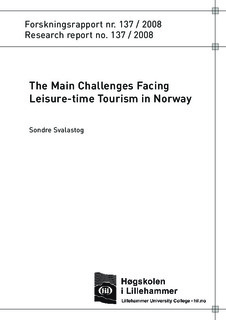The main challenges facing leisure-time tourism in Norway
Research report
Permanent lenke
http://hdl.handle.net/11250/144877Utgivelsesdato
2008Metadata
Vis full innførselSamlinger
Sammendrag
In the period after the Second World War, that part of Norwegian tourism industry which is
exposed to competition has gone from being an industry with increasing competitiveness1 to
being an industry with rapidly declining competitiveness. The competitiveness reached its
highest point in 1966. In that year, the export value was 120% of the import value. In 2007,
the export value was only 30% of the import value.
The most important export markets for Norwegian tourism are the same today as they were at
the end of the 19th century: Great Britain, Germany, USA, Sweden, Denmark, and the
Netherlands. In other words, the adjacent markets remain the most important.
At first sight, this may seem surprising. The aeroplane has shortened distances and globalized
the tourist industry. The growth in prosperity in every part of the world has enabled new large
groups of people to travel internationally, and an enormous simplification of the rules about
visas, passports and money transfer, beside other time-space shrinking technologies, has
greatly simplified intercontinental transfers.
The principal explanation of the development in the Norwegian tourist industry has three
aspects:
1. Competition has increased greatly. New, large-scale and competent suppliers have
emerged in every part of the world. The global supply has increased more quickly than
the demand. The large-scale producers are active product developers who invest
heavily in the creation of new demand.
2. The growth in prosperity in Norway has been exceptionally high in the last two
decades. The growth in purchasing power means that most Norwegians can make their
choices on a global basis.
3. At the same time, Norwegian tourism industry has been left behind, both in an
academic and in a professional sense.
